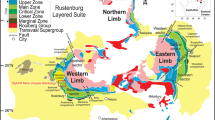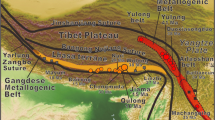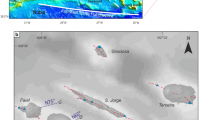Abstract
The mechanism of lithospheric removal and destruction of the North China Craton (NCC) has been hotly debated for decades. It is now generally accepted that the subduction of the (Paleo)-Pacific plate played an important role in this process. However, how the plate subduction contributed to the craton destruction remains unclear. Here we report high oxygen fugacity (fO2) characteristics of the Yunmengshan granite, e.g., hematite–magnetite intergrowth supported by zircon Ce4+/Ce3+ ratios and apatite Mn oxygen fugacity indicator. High fO2 magmas are widely discovered in Late Mesozoic (160–130 Ma) adakitic rocks in central NCC. The origin of high fO2 magma is likely related to the input of the “oxidized mantle components”, which shows a close connection between plate subduction and destruction of the craton. The research area is ~ 1500 km away from the current Pacific subduction zone. Considering the back-arc extension of Japan Sea since the Cretaceous, this distance may be shortened to ~ 800 km, which is still too far for normal plate subduction. Ridge subduction is the best candidate that was responsible for the large scale magmatism and the destruction of the NCC. Massive slab-derived fluids and/or melts were liberated into an overlying mantle wedge and modified the lithospheric mantle. Rollback of the subducting plate induced the large-scale upwelling of asthenospheric mantle and triggered the formation of extensive high fO2 intraplate magmas.







Similar content being viewed by others
References
Ballard JR, Palin MJ, Campbell IH (2002) Relative oxidation states of magmas inferred from Ce(IV)/Ce(III) in zircon: application to porphyry copper deposits of northern Chile. Contrib Mineral Petrol 144:347–364
Ballhaus C (1993) Redox states of lithospheric and asthenospheric upper mantle. Contrib Miner Petrol 114:331–348. https://doi.org/10.1007/BF01046536
Berndt ME (1996) Reduction of CO2 during serpentinization of olivine at 300 °C and 500 bar. Geology 24:351–354
Blundy J, Wood B (1994) Prediction of crystal–melt partition coefficients from elastic moduli. Nature 372:452–454
Brounce M, Kelley KA, Cottrell E, Reagan MK (2015) Temporal evolution of mantle wedge oxygen fugacity during subduction initiation. Geology 43:775–778. https://doi.org/10.1130/G36742.1
Davis GA, Qian XL, Zheng YD (1996) Mesozonic deformation and plutonism in the Yunmengshan, a metamorphic core complex north of Beijing, China. In The tectonic evolution of Asia. Cambridge University Press, Cambridge, pp 253–279
Davis GA, Yadong Z, Cong W, Darby BJ, Changhou Z, Gehrels G (2001) Mesozoic tectonic evolution of the Yanshan fold and thrust belt, with emphasis on Hebei and Liaoning provinces, northern China. Mem Geol Soc Am 194:171–198
Evans KA (2012) The redox budget of subduction zones. Earth Sci Rev 113:11–32. https://doi.org/10.1016/j.earscirev.2012.03.003
Evans KA, Reddy SM, Tomkins AG, Crossley RJ, Frost BR (2017) Effects of geodynamic setting on the redox state of fluids released by subducted mantle lithosphere. Lithos 278:26–42. https://doi.org/10.1016/j.lithos.2016.12.023
Fan WM, Menzies M (1992) Destruction of aged lower lithosphere and accretion of asthenosphere mantle beneath eastern China. Geotecton Metallog 16:171–180
Frost DJ, McCammon CA (2008) The redox state of Earth’s mantle. Annu Rev Earth Planet Sci 36:389–420
Gao S, Rudnick RL, Yuan HL, Liu XM (2004) Recycling lower continental crust in the North China craton. Nature 432:892
Gao YF, Santosh M, Hou ZQ, Wei RH, Ma GX, Chen ZK, Wu JL (2012) High Sr/Y magmas generated through crystal fractionation: evidence from Mesozoic volcanic rocks in the northern Taihang orogen. North China Craton Gondwana Res 22:152–168. https://doi.org/10.1016/j.gr.2011.11.002
Grocke SB, Cottrell E, de Silva S, Kelley KA (2016) The role of crustal and eruptive processes versus source variations in controlling the oxidation state of iron in Central Andean magmas. Earth Planet Sci Lett 440:92–104. https://doi.org/10.1016/j.epsl.2016.01.026
Harrison TM, Watson EB (1984) The behavior of apatite during crustal anatexis: equilibrium and kinetic considerations. Geochim Cosmochim Acta 48:1467–1477. https://doi.org/10.1016/0016-7037(84)90403-4
Jolivet L, Tamaki KK, Fournier M (1994) Japan Sea, opening history and mechanism: a synthesis. J Geophy Res: Solid Earth 99 (B11):22237–22259
Kelemen PB, Hanghøj K, Greene AR (2003) One view of the geochemistry of subduction-related magmatic arcs, with an emphasis on primitive andesite and lower crust. Treatise Geochem 3:593–659
Kelley KA, Cottrell E (2009) Water and the oxidation state of subduction zone magmas. Science 325:605–607
Kelley KA, Cottrell E (2012) The influence of magmatic differentiation on the oxidation state of Fe in a basaltic arc magma. Earth Planet Sci Lett 329–330:109–121. https://doi.org/10.1016/j.epsl.2012.02.010
Krishnamurthy P (2015) Modelling of magmatic and allied processes. J Geol Soc India 85:385. https://doi.org/10.1007/s12594-015-0228-1
Kusky TM, Windley BF, Wang L, Wang ZS, Li XY, Zhu PM (2014) Flat slab subduction, trench suction, and craton destruction: comparison of the North China, Wyoming, and Brazilian cratons. Tectonophysics 630:208–221
Lécuyer C, Ricard Y (1999) Long-term fluxes and budget of ferric iron: implication for the redox states of the Earth’s mantle and atmosphere. Earth Planet Sci Lett 165:197–211. https://doi.org/10.1016/S0012-821X(98)00267-2
Lee CA, Leeman WP, Canil D, Li ZXA (2005) Similar V/Sc systematics in MORB and arc basalts: implications for the oxygen fugacities of their mantle source regions. J Petrol 46:2313–2336. https://doi.org/10.1093/petrology/egi056
Lee CA, Luffi P, Le Roux V, Dasgupta R, Albaréde F, Leeman WP (2010) The redox state of arc mantle using Zn/Fe systematics. Nature 468:681
Liang HY et al (2006) Zircon Ce4+/Ce3+ ratios and ages for Yulong ore-bearing porphyries in eastern Tibet. Miner Depos 41:152
Ling MX et al (2009) Cretaceous ridge subduction along the lower yangtze river belt. East China Econ Geol 104:303–321
Ling MX, Wang FY, Ding X, Zhou JB, Sun WD (2011) Different origins of adakites from the Dabie Mountains and the Lower Yangtze River Belt, eastern China: geochemical constraints. Int Geol Rev 53:727–740. https://doi.org/10.1080/00206814.2010.482349
Ling MX et al (2013) Destruction of the North China Craton induced by ridge subductions. J Geol 121:197–213
Liu DY, Nutman AP, Compston W, Wu JS, Shen QH (1992) Remnants of ≥ 3800 Ma crust in the Chinese part of the Sino-Korean craton. Geology 20:339–342
Liu YS, Gao S, Kelemen PB, Xu W (2008) Recycled crust controls contrasting source compositions of Mesozoic and Cenozoic basalts in the North China Craton. Geochim Cosmochim Acta 72:2349–2376. https://doi.org/10.1016/j.gca.2008.02.018
Liu SA, Li SG, He YS, Huang F (2010) Geochemical contrasts between early Cretaceous ore-bearing and ore-barren high-Mg adakites in central-eastern China: implications for petrogenesis and Cu–Au mineralization. Geochim Cosmochim Acta 74:7160–7178. https://doi.org/10.1016/j.gca.2010.09.003
Liu J, Wang ZZ, Yu HR, Xia QK, Deloule E, Feng M (2017) Dynamic contribution of recycled components from the subducted Pacific slab: Oxygen isotopic composition of the basalts from 106 Ma to 60 Ma in North China Craton. J Geophys Res Solid Earth 122:988–1006. https://doi.org/10.1002/2016jb013156
Menzies MA, Fan WM, Zhang M (1993) Palaeozoic and Cenozoic lithoprobes and the loss of > 120 km of Archaean lithosphere, Sino-Korean craton, China. Geol Soc Lond Spec Publ 76:71–81. https://doi.org/10.1144/gsl.sp.1993.076.01.04
Menzies M, Xu Y, Zhang H, Fan W (2007) Integration of geology, geophysics and geochemistry: a key to understanding the North China Craton. Lithos 96:1–21. https://doi.org/10.1016/j.lithos.2006.09.008
Miles AJ, Graham CM, Hawkesworth CJ, Gillespie MR, Hinton RW, Bromiley GD (2014) Apatite: a new redox proxy for silicic magmas? Geochim Cosmochim Acta 132:101–119
Niu YL (2005) Generation and evolution of basaltic magmas: some basic concepts and a new on the origin of Mesozonic-Cenozoic basaltic volcanism in the Earstern China. Geol J China Univ 11:9–46
O’Neill HSC (1987) Quartz-fayalite-iron and quartz-fayalite-magnetite equilibria and the free energy of formation of fayalite (Fe2SiO4) and magnetite (Fe3O4). Am Mineral 72:67–75
Rielli A et al (2017) Evidence of sub-arc mantle oxidation by sulphur and carbon Geochemical. Perspectives 3:124–132
Sun SS, McDonough WF (1989) Chemical and isotopic systematics of oceanic basalts: implications for mantle composition and processes. Geol Soc Lond Special Publ 42:313–345. https://doi.org/10.1144/gsl.sp.1989.042.01.19
Sun WD, Ding X, Hu YH, Li XH (2007) The golden transformation of the Cretaceous plate subduction in the west Pacific. Earth Planet Sci Lett 262:533–542
Sun JF, Yang JH, Wu FY, Li X, Yang YP, Xie LW, Wilde SA (2010) Magma mixing controlling the origin of the Early Cretaceous Fangshan granitic pluton, North China Craton: in situ U-Pb age and Sr-, Nd-, Hf- and O-isotope evidence. Lithos 120:421–438. https://doi.org/10.1016/j.lithos.2010.09.002
Sun WD et al (2013) The link between reduced porphyry copper deposits and oxidized magmas. Geochim Cosmochim Acta 103:263–275
Sun WD et al (2015) Porphyry deposits and oxidized magmas. Ore Geol Rev 65:97–131
Sun WD, Li CY, Hao XL, Ling MX, Ireland T, Ding X, Fan WM (2016) Oceanic anoxic events, subduction style and molybdenum mineralization. Solid Earth Sci 1:64–73. https://doi.org/10.1016/j.sesci.2015.11.001
Sun SJ, Zhang LP, Zhang RQ, Ding X, Zhu HL, Zhang ZF, Sun WD (2018a) Mid-Late Cretaceous igneous activity in South China: the Qianjia example, Hainan Island. Int Geol Rev 60(11–14):1665–1683
Sun SJ, Ireland TR, Zhang LP, Zhang RQ, Zhang CC, Sun WD, (2018b) Palaeoarchaean materials in the Tibetan Plateau indicated by zircon. Int Geol Rev 60(8):1061–1072
Sun SJ, Yang XY, Wang GJ, Sun WD, Zhang H, Li CY, Ding X (2019) In situ elemental and Sr-O isotopic studies on apatite from the Xu-Huai intrusion at the southern margin of the North China Craton: Implications for petrogenesis and metallogeny. Chem Geol 510:200–214
Wang Q et al (2007) Early Cretaceous adakitic granites in the Northern Dabie Complex, central China: Implications for partial melting and delamination of thickened lower crust. Geochim Cosmochim Acta 71:2609–2636. https://doi.org/10.1016/j.gca.2007.03.008
Wang T et al (2012) Timing and processes of Late Mesozoic mid-lower-crustal extension in continental NE Asia and implications for the tectonic setting of the destruction of the North China Craton: mainly constrained by zircon U-Pb ages from metamorphic core complexes. Lithos 154:315–345
Wu FY, Sun DY, Li HM, Jahn BM, Wilde S (2002) A-type granites in northeastern China: age and geochemical constraints on their petrogenesis. Chem Geol 187:143–173. https://doi.org/10.1016/S0009-2541(02)00018-9
Wu FY, Lin JQ, Wilde SA, Zhang XO, Yang JH (2005a) Nature and significance of the Early Cretaceous giant igneous event in eastern China. Earth Planet Sci Lett 233:103–119
Wu FY, Yang JH, Wilde SA, Zhang XO (2005b) Geochronology, petrogenesis and tectonic implications of Jurassic granites in the Liaodong Peninsula, NE China. Chem Geol 221:127–156. https://doi.org/10.1016/j.chemgeo.2005.04.010
Wu K, Ling MX, Sun WD, Guo J, Zhang CC (2017) Major transition of continental basalts in the Early Cretaceous: implications for the destruction of the North China Craton. Chem Geol. https://doi.org/10.1016/j.chemgeo.2017.08.025
Xia QK, Liu J, Liu SC, Kovács I, Feng M, Dang L (2013) High water content in Mesozoic primitive basalts of the North China Craton and implications on the destruction of cratonic mantle lithosphere. Earth Planet Sci Lett 361:85–97
Xu YG (2001) Thermo-tectonic destruction of the archaean lithospheric keel beneath the sino-korean craton in china: evidence, timing and mechanism. Phys Chem Earth A Solid Earth Geod 26:747–757. https://doi.org/10.1016/S1464-1895(01)00124-7
Xu YG et al (2004) Crust-mantle interaction during the tectono-thermal reactivation of the North China Craton: constraints from SHRIMP zircon U-Pb chronology and geochemistry of Mesozoic plutons from western Shandong. Contrib Miner Petrol 147:750–767. https://doi.org/10.1007/s00410-004-0594-y
Xu HJ, Song YR, Ye K, Zhang JF, Wang HR (2012) Petrogenesis of mafic dykes and high-Mg adakitic enclaves in the Late Mesozoic Fangshan low-Mg adakitic pluton, North China Craton. J Asia Earth Sci 54–55:143–161
Yang JH, Wu FY, Wilde SA, Belousova E, Griffin WL (2008) Mesozoic decratonization of the North China block. Geology 36:467–470
Zhang HF, Sun M, Zhou XH, Fan WM, Zhai MG, Yin JF (2002) Mesozoic lithosphere destruction beneath the North China Craton: evidence from major-, trace-element and Sr-Nd-Pb isotope studies of Fangcheng basalts. Contrib Mineral Petrol 144:241–254
Zhang HF, Sun M, Zhou XH, Zhou MF, Fan WM, Zheng JP (2003) Secular evolution of the lithosphere beneath the eastern North China Craton: evidence from Mesozoic basalts and high-Mg andesites. Geochim Cosmochim Acta 67:4373–4387. https://doi.org/10.1016/S0016-7037(03)00377-6
Zhang H et al (2013) High oxygen fugacity and slab melting linked to Cu mineralization: evidence from dexing porphyry copper deposits, Southeastern China. J Geol 121:289–305. https://doi.org/10.1086/669975
Zhang CC, Sun WD, Wang JT, Zhang LP, Sun SJ, Wu K (2017) Oxygen fugacity and porphyry mineralization: a zircon perspective of Dexing porphyry Cu deposit, China. Geochim Cosmochim Acta 206:343–363
Zhao MT, Wang Y (2014) Geochemical characteristics and petrogenesis of the Shicheng diorite and Yunmengshan granite in Beijing area. Mineral Petrol 34:60–69
Zhao GC, Wilde SA, Cawood PA, Sun M (2001) Archean blocks and their boundaries in the North China Craton: lithological, geochemical, structural and P-T path constraints and tectonic evolution. Precambrian Res 107:45–73
Zhao DP, Maruyama S, Omori S (2007) Mantle dynamics of Western Pacific and East Asia: insight from seismic tomography and mineral physics. Gondwana Res 11:120–131. https://doi.org/10.1016/j.gr.2006.06.006
Zhao T, Zhu G, Lin S, Wang HJE-SR (2016) Indentation-induced tearing of a subducting continent: evidence from the Tan–Lu Fault Zone, East China. Earth Sci Rev 152:14–36
Zheng JP, Griffin WL, O’Reilly SY, Yu CM, Zhang H, Pearson N, Zhang M (2007) Mechanism and timing of lithospheric modification and replacement beneath the eastern North China Craton: peridotitic xenoliths from the 100 Ma Fuxin basalts and a regional synthesis. Geochim Cosmochim Acta 71:5203–5225. https://doi.org/10.1016/j.gca.2007.07.028
Zhu RX, Chen L, Wu FY, Liu JL (2011) Timing, scale and mechanism of the destruction of the North China Craton. Sci China Earth Sci 54:789–797. https://doi.org/10.1007/s11430-011-4203-4
Zhu RX, Yang JH, Wu FY (2012) Timing of destruction of the North China Craton. Lithos 149:51–60
Zhu G, Chen Y, Jiang DZ, Lin SZ (2015) Rapid change from compression to extension in the North China Craton during the Early Cretaceous: evidence from the Yunmengshan metamorphic core complex. Tectonophysics 656:91–110
Acknowledgements
This study was supported by National Key R&D Program of China (2016YFC0600408), Strategic Priority Research Program (B) of the Chinese Academy of Sciences (XDB18020102), Guangdong Natural Science Funds (2014A030306032 and 2015TQ01Z611), and Youth Innovation Promotion Association CAS (2016315). We thank Drs. Rongqing Zhang and Liuyi Zhang for their assistance of field work. No. IS-2794 from GIGCAS has a contribution in this work.
Author information
Authors and Affiliations
Corresponding author
Electronic supplementary material
Below is the link to the electronic supplementary material.
Rights and permissions
About this article
Cite this article
Zhang, Z., Ling, M., Zhang, L. et al. High oxygen fugacity magma: implication for the destruction of the North China Craton. Acta Geochim 39, 161–171 (2020). https://doi.org/10.1007/s11631-020-00394-7
Received:
Revised:
Accepted:
Published:
Issue Date:
DOI: https://doi.org/10.1007/s11631-020-00394-7




